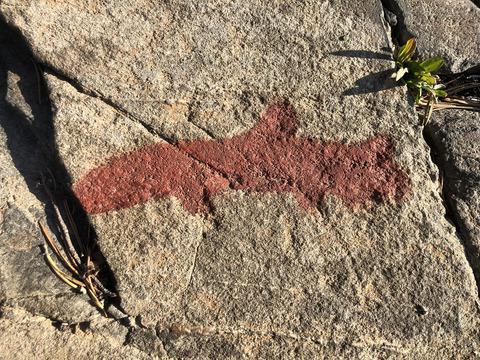当前位置:
X-MOL 学术
›
J. Anim. Ecol.
›
论文详情
Our official English website, www.x-mol.net, welcomes your
feedback! (Note: you will need to create a separate account there.)
Holocene extinctions of a top predator – Effects of time, habitat area and habitat subdivision
Journal of Animal Ecology ( IF 3.5 ) Pub Date : 2020-02-12 , DOI: 10.1111/1365-2656.13174 Göran Englund 1 , Gunnar Öhlund 1 , Fredrik Olajos 1 , Anders Finstad 2 , Celine Bellard 3, 4 , Bernard Hugueny 5
Journal of Animal Ecology ( IF 3.5 ) Pub Date : 2020-02-12 , DOI: 10.1111/1365-2656.13174 Göran Englund 1 , Gunnar Öhlund 1 , Fredrik Olajos 1 , Anders Finstad 2 , Celine Bellard 3, 4 , Bernard Hugueny 5
Affiliation

|
Loss of habitat and changes in the spatial configuration of habitats are major drivers of species extinctions, but the responses to these drivers differ between organisms. To advance theory on how extinction risk from different types of habitat alteration relate to species-specific traits, there is a need for studies of the long-term extinction dynamic of individual species. The goal of this study was to quantify how habitat area and the spatial configuration of habitats affect extinction rate of an aquatic top-predator, the northern pike Esox lucius L. We recorded presence/absence of northern pike in 398 isolated habitat fragments, each one consisting of a number of interconnected lakes. Time since isolation of the habitat fragments, caused by cut-off from the main dispersal source in the Baltic Sea, varied between 0 and 10 000 years. Using survival regression, we analysed how pike population survival was affected by time since isolation, habitat size, and habitat subdivision. The approach builds on the assumptions that pike colonized all fragments before isolation and that current absences result from extinctions. We verified these assumptions by testing i) if pike was present in the region throughout the entire time period when the lakes formed, and ii) if pike typically colonize lakes that are formed today. We also addressed the likelihood that unrecorded anthropogenic introductions could bias our estimates of extinction rate. Our results supported the interpretation that current patterns of presence/absence in our study system are shaped by extinctions. Further, we found that time since isolation and fragment area had strong effects on pike population survival. In contrast, spatial habitat subdivision (i.e., if a fragment contained few large lakes or many small lakes) and other environmental covariates describing climate and productivity, were unrelated to pike survival. Over all, extinction rate was high in young fragments and decreased sharply with increasing fragment age. Our study demonstrates how the link between extinction rate and habitat size and spatial structure can be quantified. More similar studies may help us find generalizations that can guide management of habitat size and connectivity.
中文翻译:

顶级捕食者的全新世灭绝——时间、栖息地面积和栖息地细分的影响
栖息地的丧失和栖息地空间配置的变化是物种灭绝的主要驱动因素,但生物对这些驱动因素的反应不同。为了推进关于不同类型栖息地改变的灭绝风险如何与物种特定特征相关的理论,需要研究单个物种的长期灭绝动态。这项研究的目的是量化栖息地面积和栖息地的空间配置如何影响水生顶级捕食者北梭鱼 Esox lucius L 的灭绝率。我们记录了 398 个孤立的栖息地碎片中北梭鱼的存在/不存在,每个碎片由许多相互连接的湖泊组成。由于与波罗的海的主要扩散源切断而导致栖息地碎片隔离以来的时间在 0 到 10 000 年之间变化。使用生存回归,我们分析了自隔离、栖息地大小和栖息地细分以来的时间如何影响梭鱼种群的生存。该方法建立在以下假设之上:梭鱼在隔离之前已在所有碎片上定居,并且目前的缺失是由于灭绝造成的。我们通过以下测试验证了这些假设:i) 在湖泊形成的整个时间段内该地区是否都存在梭鱼,以及 ii) 梭鱼是否通常定居在今天形成的湖泊中。我们还解决了未记录的人为引入可能使我们对灭绝率的估计产生偏差的可能性。我们的结果支持了我们研究系统中当前存在/不存在模式是由灭绝塑造的解释。此外,我们发现隔离和碎片区域的时间对梭鱼种群的生存有很强的影响。相比之下,空间栖息地细分(即,如果一个片段包含几个大湖泊或许多小湖泊)和其他描述气候和生产力的环境协变量,与梭鱼的生存无关。总的来说,年轻碎片的灭绝率很高,随着碎片年龄的增加而急剧下降。我们的研究展示了如何量化灭绝率与栖息地大小和空间结构之间的联系。更多类似的研究可能会帮助我们找到可以指导栖息地大小和连通性管理的概括。我们的研究展示了如何量化灭绝率与栖息地大小和空间结构之间的联系。更多类似的研究可能会帮助我们找到可以指导栖息地大小和连通性管理的概括。我们的研究展示了如何量化灭绝率与栖息地大小和空间结构之间的联系。更多类似的研究可能会帮助我们找到可以指导栖息地大小和连通性管理的概括。
更新日期:2020-02-12
中文翻译:

顶级捕食者的全新世灭绝——时间、栖息地面积和栖息地细分的影响
栖息地的丧失和栖息地空间配置的变化是物种灭绝的主要驱动因素,但生物对这些驱动因素的反应不同。为了推进关于不同类型栖息地改变的灭绝风险如何与物种特定特征相关的理论,需要研究单个物种的长期灭绝动态。这项研究的目的是量化栖息地面积和栖息地的空间配置如何影响水生顶级捕食者北梭鱼 Esox lucius L 的灭绝率。我们记录了 398 个孤立的栖息地碎片中北梭鱼的存在/不存在,每个碎片由许多相互连接的湖泊组成。由于与波罗的海的主要扩散源切断而导致栖息地碎片隔离以来的时间在 0 到 10 000 年之间变化。使用生存回归,我们分析了自隔离、栖息地大小和栖息地细分以来的时间如何影响梭鱼种群的生存。该方法建立在以下假设之上:梭鱼在隔离之前已在所有碎片上定居,并且目前的缺失是由于灭绝造成的。我们通过以下测试验证了这些假设:i) 在湖泊形成的整个时间段内该地区是否都存在梭鱼,以及 ii) 梭鱼是否通常定居在今天形成的湖泊中。我们还解决了未记录的人为引入可能使我们对灭绝率的估计产生偏差的可能性。我们的结果支持了我们研究系统中当前存在/不存在模式是由灭绝塑造的解释。此外,我们发现隔离和碎片区域的时间对梭鱼种群的生存有很强的影响。相比之下,空间栖息地细分(即,如果一个片段包含几个大湖泊或许多小湖泊)和其他描述气候和生产力的环境协变量,与梭鱼的生存无关。总的来说,年轻碎片的灭绝率很高,随着碎片年龄的增加而急剧下降。我们的研究展示了如何量化灭绝率与栖息地大小和空间结构之间的联系。更多类似的研究可能会帮助我们找到可以指导栖息地大小和连通性管理的概括。我们的研究展示了如何量化灭绝率与栖息地大小和空间结构之间的联系。更多类似的研究可能会帮助我们找到可以指导栖息地大小和连通性管理的概括。我们的研究展示了如何量化灭绝率与栖息地大小和空间结构之间的联系。更多类似的研究可能会帮助我们找到可以指导栖息地大小和连通性管理的概括。











































 京公网安备 11010802027423号
京公网安备 11010802027423号